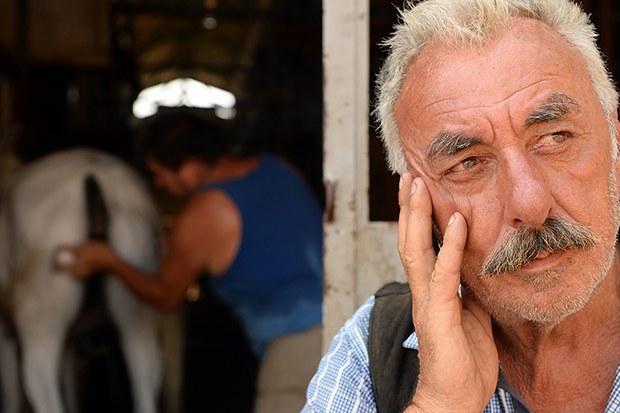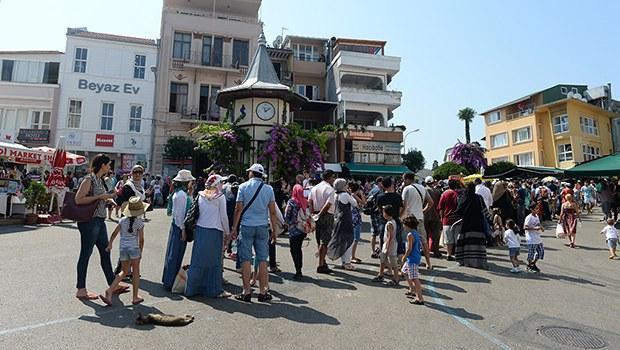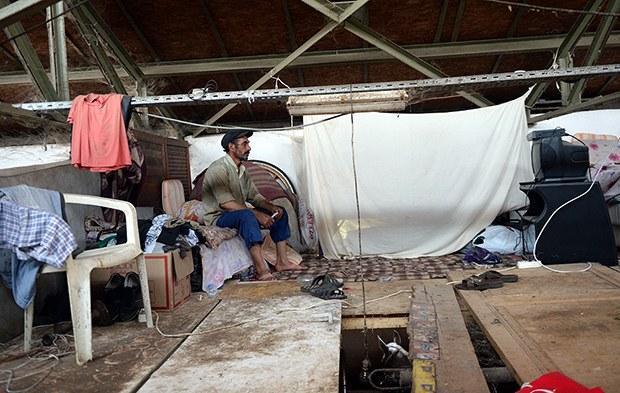The suffering horses of an Istanbul island
Burak Kuru -ISTANBUL / Photo: Murat Şaka

I feel guilty when I am on the roads of Büyükada with the carriage of 63-year-old Selahattin Gürsözlü, but I need his guidance and his carriage to the stables.
The stables are at the top of the island, next to the cemetery. “When horses die, the municipality takes them away with excavators. They dig a grave, and bury them with lime. They bury them near the junkyard,” says Gürsözlü.
There are 227 carriages on the island, and each carriage has five to six horses, meaning that there are around 1,500 horses in total. Coaches take the road at 7 o’clock each morning. A couple of horses pull the carriage until midday, and the second pair departs at 2:30 p.m. The remaining two horses take the coach the next day. One of three pairs rest every day while the other two work — at least on paper.
We are at the first stable, where the stablemen say the horses are treated even better than their own children. I have to agree that these horses are treated well, but there are 13 more stables that people have advised us to avoid. That is suspicious.
One horse live and can pull a carriage for more than 14 years, or just for one. The most important factors determining this are the weather and the working routine. “They sometimes can’t handle the heat,” says Gürsözlü. What do they do to the horses that can’t handle the heat? “Sometimes the horse faints. We bring it into the shade, wash its face and let it rest.” They also do medical treatments. When a horse suffers from cramps, they use Lasix. Sometimes drinking water causes gas, so the medicine helps the horses urinate to relieve the pain.
“The islanders do not want the horses here, but the tourists and foreigners come for them,” Gürsözlu says. “When there are electric cars, everyone will buy one and they won’t need us coachmen.” Still, the carriages are also used for transportation as much as they are for pleasure. They remain on the streets from 7 a.m. until midnight, when the last ferries arrive.

The coachmen claim that many people also make their living by taking care of the horses. But are those people living in good conditions themselves?
“We are living with the horses in the stables. We are just a floor above where they live,” says Cemil Polat, a stableman. “I tell my children: ‘I’m working for you to study.’ What else could I do?”
Polat began working in stables three years ago, while he was a farmer in the eastern Turkish province of Muş for the rest of the year. He lives with the horses and his term lasts for 90 days. Throughout this period he receives 50 Turkish Liras per day for maintaining a carriage, 100 liras a day for maintaining two, and 120 liras a day for three. He has six children; two of his daughters are married, and he looks after the other four by himself.
“They used to talk to me about Istanbul as a child and I was enthusiastic about coming here. Well, here I am. My friends in Muş tell me, ‘You are in a superb place,’ but they don’t really know what [conditions] I am living in!” Polat says.
Selahattin Yolcu “returned to the game” this year, after 10 years during which he could not find a job. He was paid in advance for this job. He is 41 years old and has five children.
These are just the words of people who knew that what they were saying would be published. The scenario gets worse when we go out onto the streets.
The horses that return to the stables after their shifts are exhausted, as is clear from their stances and the tears coming from their eyes.
We are sternly warned about not taking photos of the horses between their shifts. But our photographer Murat Şaka insists on taking photos. I wonder, “Would the stablemen be on our side if there was a riot?”
No, they are on the side of the carriage drivers. “This is our bread. People come here for this tradition, for this smell,” they say.
Whenever I ask the coach drivers about the scars on the horses, they answer, “They hit each other with their feet.” There is no solution.
Actually there is. “Take this bottle of water, then urinate in it. Then pour that on the horses' scars. That’s the best cure,” the riders say to a young boy.
There are photographs that show horses dead in the middle of the island, their decapitated bodies being eaten by dogs. But they are too gruesome to publish.
The locals talk about the coach drivers suggestively. They complain about prices and they claim that the coach drivers do not respect the official fees. But the biggest complaint focuses on public security. "Wanted" criminals were found with drugs in police raids on stables.
Meanwhile, this year alone eight fatal accidents involving carriages have been recorded. Some of them involve crashes between carriages and bicycles.
So, what’s the solution? The only motor vehicles allowed on the island are for public services such as ambulances, garbage trucks and post office cars. One of the first solutions that comes to mind is the “electric carriage.” But Can Atalay, a lawyer for the Istanbul Chamber of Architects, warns that this could lead to motor vehicles being allowed on the island. “You shouldn’t forget that there are plans to facilitate the introduction of motor vehicles to the islands, starting with electric cars.”
Kadir Topbaş, the mayor of Istanbul, has proposed another alternative through the introduction of “nostalgic trams,” though a proposition similar to the trams in Beyoğlu was previously declined. People are looking for other solutions that would maintain the island’s serenity by excluding motorized vehicles while protecting the horses from exhaustion. Due to fears of corruption, nobody has been able to take a step toward realizing the project.
The lack of proper treatment and the exhaustion of Büyükada's horses have lately been attracting reactions. Over the past weekend, animal rights activists organized a protest on the island, demanding the release of its horses and proposing the use of electric cars for transportation instead.
70 km — The average distance a horse pulls a phaeton carriage during its 7-hour shift
500 - The number of horses that have died due to “ruam” disease.
100-140 — The average number of horses officially diagnosed with “ruam” disease.
250-300 liras - The average daily income of a coach driver during the summer season.

Translated by Yunus Yüzsüren
Edited by Delphine Rodrik
 I feel guilty when I am on the roads of Büyükada with the carriage of 63-year-old Selahattin Gürsözlü, but I need his guidance and his carriage to the stables.
I feel guilty when I am on the roads of Büyükada with the carriage of 63-year-old Selahattin Gürsözlü, but I need his guidance and his carriage to the stables. 

















